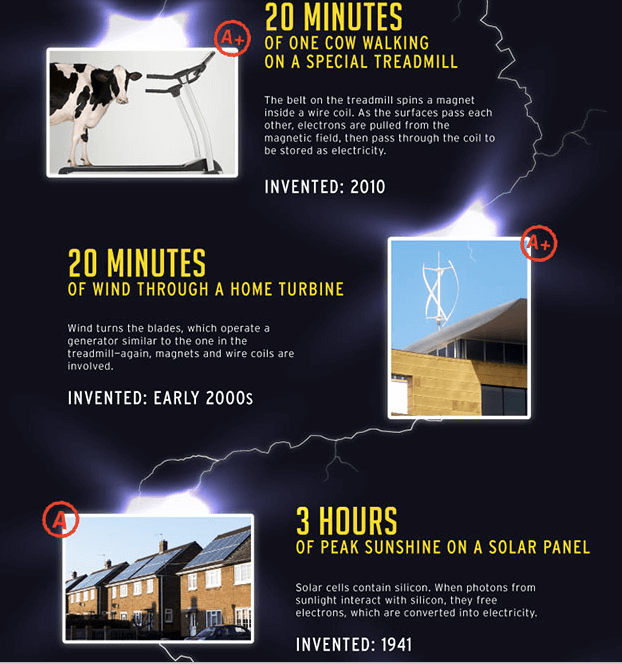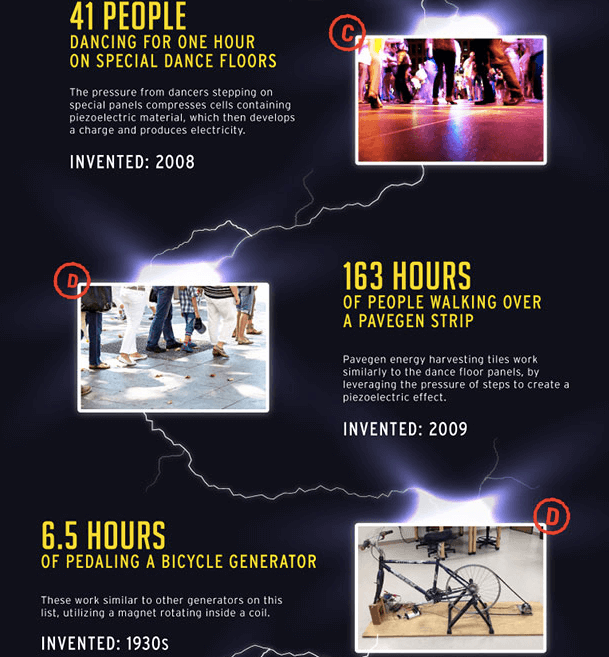If you’re reading this, chances are you work in the power industry. But when you flip on the first light in the morning or brew your coffee, chances are the electricity that powers those devices isn’t top of mind. That power is a privilege most of us in North America take for granted.
Nevertheless, electricity endures a lengthy journey before it gets to the sockets and switches in your home and office. That journey may start many different ways, so we have a challenge for you, courtesy of the Chicago based engineers and consultants at KDM Engineering.

What would it take to generate 0.65 kWh of electricity, or enough to power a 60-inch TV to watch the Super Bowl? Here are a few ideas. Click to check out the full graphic.
The challenge
Forget the coffee maker and consider this: what does it take to power a 60-inch plasma television for the four hours surrounding the Super Bowl? How much electricity is needed? KDM Engineering estimates about 0.65 kilowatt-hours (kWh). Of course, the number is relative and may seem like a lot or little.
To provide perspective, consider this: the average monthly consumption for a U.S. household is 903 kWh, or more than 1,300 times the amount of electricity needed to watch several hours on that TV.
Interestingly, Louisiana had the highest annual electricity consumption at 15,435 kWh per residential customer. Hawaii had the lowest at 6,166 kWh per residential customer in 2015, according to the U.S. Energy Information Administration.
To make the question more interesting, KDM further asks, what if your utility did not exist? What would it take, regardless of generation method, to power up our TV for the Super Bowl?
The methods
KDM Engineering suggests a range of possibilities from conventional to crazy. For example, nearly half of the possibilities involve conventional generators that rely on rotation of magnets inside coils to produce electricity. Two other methods involve heat and three rely on piezoelectric materials.
The piezoelectric effect is the ability of certain materials to generate an electric charge in response to applied mechanical stress. (Piezoelectric is derived from the Greek word “piezein,” which means to squeeze or press, and “piezo,” which means to push.)
Our favorite examples from the KDM list include 38,000 potatoes turned into batteries or the dance-off, which entails over 40 people dancing for an hour on special piezoelectric cells. That sounds fun, although we would put our money on utility-scale thinking.

The average monthly electricity consumption for a U.S. household is 903 kWh, or more than 1,300 times the amount of electricity needed to watch several hours on the TV.
For instance, in the last decade, solar power has experienced a compound annual growth rate of more than 60%. There are about 209,000 Americans working in solar right now, according to the National Solar Jobs Census. That number has doubled since 2010, and is expected to double again by 2020.
The wind industry has more to boast about too. The U.S. Department of Energy just released new data that wind employs over 100,000 Americans, which is more than work at nuclear, natural gas, coal, or hydroelectric power plants. Also, another 380,000 American wind jobs could be created by 2030.
In fact, wind-turbine technician is by far the country’s fastest growing job. The Bureau of Labor Statistics says the occupation will grow by 108% over the next decade. (That blows past the second fastest growing job, occupational therapy assistant, which is projected to grow by 42% in the same time frame.)
Wind energy is also one of the most affordable forms of electricity available in the U.S. today. Studies show the levelized cost of energy for wind has reduced more than 60% over the last six years. After hitting a temporary high of 7 cents per kW in 2009, the average levelized long-term price from wind power sales agreements has now dropped to around 2 cents per kW.
Although you may not have the choice how to power your TV, a few electric-utility customers in the U.S. do have the option to choose an alternate electricity supplier. The Department of Energy made a list of the top 10 “green” utilities in 2015 that can be viewed here.
Filed Under: News




